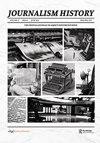News Media as Artifacts of Loss: Journalism History in the 9/11 Museum
Q4 Social Sciences
引用次数: 1
Abstract
With the passage of two decades, the story of September 11, 2001, is moving out of living memory and into recorded history. This essay considers the place of journalism within this transition, focusing on the uses of news media inside the 9/11 Museum in New York City, which has drawn more than 17 million visitors since its May 2014 opening. For years after the attacks, journalism was central to public retellings of the 9/11 story. Many of those accounts came from journalism itself, as major news organizations created special supplements, issues, programs, and books, repackaging their own original coverage of the event and recalling journalists’ memories of covering the story. In 2008, the first permanent exhibit about 9/11 opened as part of the Newseum, a Washington, DC, institution funded by news corporations. Journalism was obviously its main focus, with interpretation including newspaper front pages, a film in which reporters shared their terrifying experiences, and an enormous artifact, part of the broadcast antenna that once topped World Trade Center Tower One. When New York’s 9/11 Museum opened six years later, in 2014, its most powerful artifact was its site, the cement foundation of the former Twin Towers. Within their footprints are thousands of other material artifacts that Marita Sturken calls “survivor objects,” from the mundane (paper memos) and personal (shoes) to the structural (twisted steel) and heroic (a crushed fire truck). Most scholarship about this site focuses on these kinds of objects, but the museum also contains news-media survivors. News photographs are plentiful among the digital mediation that visitors encounter as they descend wide ramps to the main displays below ground. While they are documentary images, they are similar in perspective, showing people on the streets of Manhattan looking forward in tears or upward in horror. In the weeks after the attacks, many of these pictures appeared in national newsmagazines and in photography exhibits through which New Yorkers processed the catastrophe. In the museum today, they are displayed at eye level as the visitor walks among them; they are indexical in a way that obscures mediation, inviting visitors into a relay of seeing that makes us forget that someone took the picture. News media are mentioned, however, in audio and written words projected around these “Dark City,” by Dennis Leung (CC BY 2.0)新闻媒体作为遗失的文物:9/11博物馆的新闻史
随着二十年的过去,2001年9月11日的故事正在从人们的记忆中走出来,进入有记录的历史。本文考虑了新闻业在这一转变中的地位,重点关注纽约市9/11博物馆内新闻媒体的使用,自2014年5月开放以来,该博物馆已吸引了1700多万游客。袭击事件发生后的几年里,新闻业一直是公众复述911事件的核心。其中许多报道来自新闻业本身,因为主要新闻机构制作了特别的增刊、期刊、节目和书籍,重新包装了他们自己对这一事件的原始报道,并回忆起记者对报道这一故事的记忆。2008年,第一个关于9/11的永久性展览作为新闻博物馆的一部分开幕,新闻博物馆是华盛顿特区一家由新闻公司资助的机构。新闻业显然是它的主要关注点,包括报纸头版、一部记者分享恐怖经历的电影,以及一个巨大的人工制品,这是曾经登上世贸中心一号楼的广播天线的一部分。六年后的2014年,当纽约9/11博物馆开幕时,它最强大的文物是它的遗址,前双子塔的水泥地基。在他们的足迹中还有成千上万的其他物质文物,玛丽塔·斯特肯称之为“幸存者物品”,从平凡的(纸质备忘录)和个人的(鞋子)到结构的(扭曲的钢)和英雄的(被压碎的消防车)。关于这个网站的大多数学术都集中在这类物品上,但博物馆也有新闻媒体的幸存者。在游客从宽阔的坡道下到地面下的主要显示器时遇到的数字调解中,有大量的新闻照片。虽然它们是纪录片,但视角相似,显示了曼哈顿街头的人们泪流满面或惊恐地向上看。在袭击发生后的几周里,这些照片中的许多出现在全国性的新闻杂志和摄影展览上,纽约人通过这些展览处理了这场灾难。在今天的博物馆里,当游客走在它们中间时,它们与眼睛齐平;它们是指数化的,以一种模糊调解的方式,邀请游客观看,让我们忘记是有人拍的照片。然而,新闻媒体在Dennis Leung(CC by 2.0)围绕这些“黑暗城市”投影的音频和书面文字中被提及
本文章由计算机程序翻译,如有差异,请以英文原文为准。
求助全文
约1分钟内获得全文
求助全文

 求助内容:
求助内容: 应助结果提醒方式:
应助结果提醒方式:


